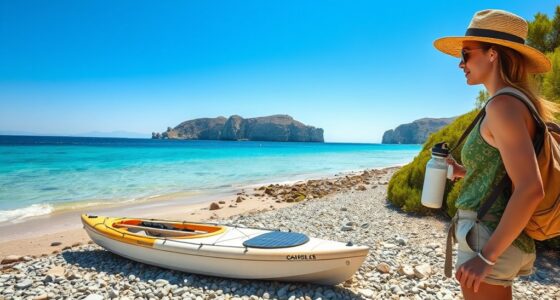To create a Mediterranean garden in your urban space, focus on drought-resistant plants like herbs, olives, and succulents that thrive with minimal water. Design small courtyards or vertical gardens to maximize space, using natural materials like terracotta and stone for an authentic look. Incorporate efficient watering systems such as drip irrigation and rainwater harvesting, and arrange plants for ideal sunlight and soil conditions. Keep your garden low-maintenance and resilient—discover more ways to turn your city spot into a Mediterranean oasis.
Key Takeaways
- Utilize small courtyard layouts with water features and architectural details to maximize space and create focal points.
- Incorporate vertical and container planting on walls and fences to optimize limited urban space.
- Choose native, drought-resistant plants like lavender, oleander, and succulents for low water needs and resilience.
- Use natural, locally sourced materials such as terracotta, limestone, and gravel to enhance Mediterranean aesthetic and sustainability.
- Implement water-saving techniques like drip irrigation, mulching, and rainwater harvesting to conserve resources efficiently.
Embracing a Courtyard-Centric Layout in Small Spaces
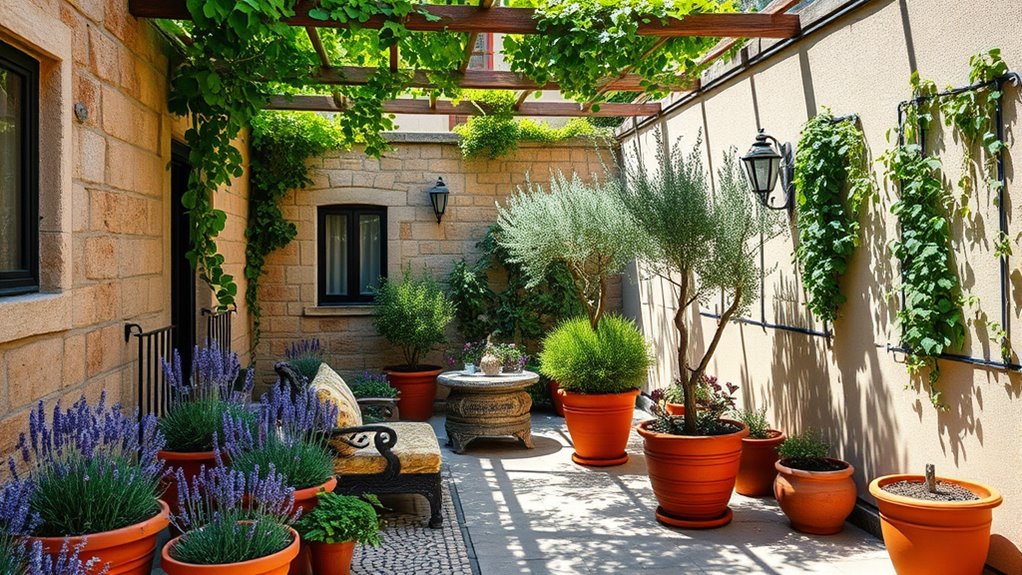
A courtyard-centric layout is an ideal solution for small Mediterranean gardens, as it creates a focal point that maximizes space and encourages outdoor living. You can enhance this area with a water feature, like a fountain or small pond, to set a calming tone. Incorporate architectural details such as stone walls or terracotta tiles to add a sense of history and permanence. To create visual interest, mix soft plants with structural elements like cypress trees, and add colorful accents like red poppies or blue salvia. Use subtle outdoor lighting to highlight key features at night. Designing pathways and seating with materials like pale gravel or tiles offers flexibility and charm. This layout invites you to enjoy outdoor moments while making the most of limited space. Design elements of Mediterranean gardens also include gravel paths replacing lawns for sustainability and authentic aesthetic.
Selecting and Arranging Drought-Resistant Plants for Urban Gardens
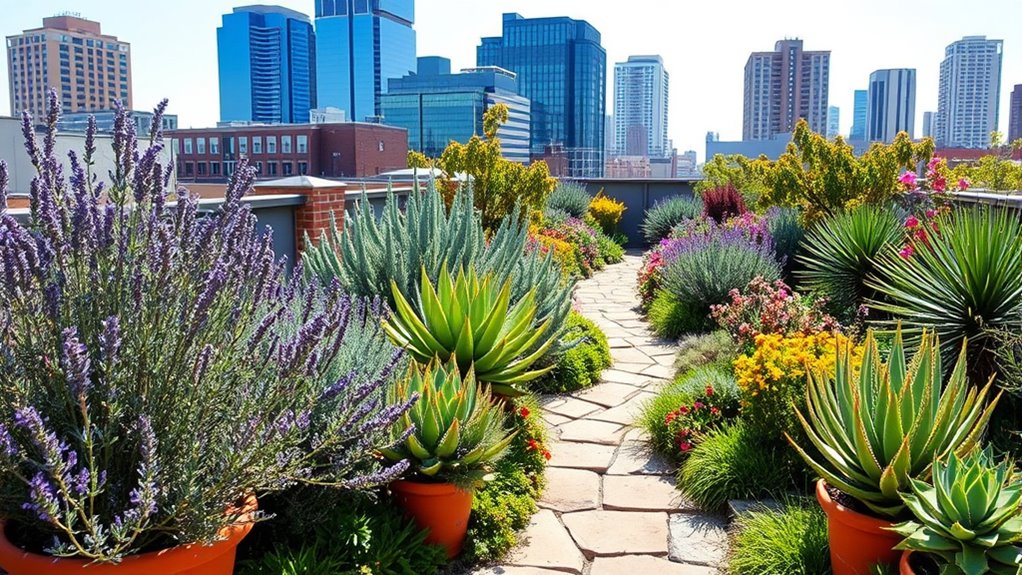
Choosing drought-resistant plants that are native to your area makes your garden more resilient and easier to maintain. Mixing textures and colors, like silvery shrubs with vibrant succulents, creates visual interest while conserving water. Make certain to match plants with similar soil and water needs to ensure healthy growth and simplify your watering schedule. Hardiness zones also play a crucial role in selecting plants that will thrive in your specific climate, reducing the need for extra care.
Native Species Benefits
Have you ever considered how native Mediterranean plants can transform your urban garden into a resilient, low-maintenance oasis? These plants have evolved to tolerate intense sunlight, drought, dry winds, and poor soils, making them highly drought-resistant. Once established, they require minimal watering, reducing your water use and maintenance efforts. Native species support local wildlife, attracting pollinators like bees and butterflies, and help preserve the regional ecosystem. Their deep roots improve soil structure, boost water infiltration, and prevent erosion. Native plants are adapted to regional climate and soil conditions, which enhances their drought tolerance and reduces the need for additional resources. Using native plants minimizes the risk of invasive species and reduces the need for chemical treatments. Incorporating them promotes biodiversity, conserves water, and enhances ecological stability—which is essential for sustainable urban gardening—creating resilient, thriving gardens that withstand Mediterranean climate stressors.
Visual Plant Combinations
Creating visually appealing drought-resistant plant combinations in your urban Mediterranean garden involves strategic grouping and thoughtful arrangement. Use drifts and clusters to mimic natural growth, enhancing visual impact. Mix textures by pairing soft, feathery foliage like lavender with bold forms such as yucca or aloe for depth. Repeated color themes—purples, silvers, and yellows—create unity across your space. Vary plant heights from low ground covers like cistus to tall structural species like yucca, adding dimension. Incorporate seasonal interest by selecting plants with staggered bloom times, ensuring year-round appeal. Contrast foliage colors—silvery Santolina against deep green rosemary—and add pops of bright flowers like yellow Santolina or pink Oleander for focal points. Use architectural succulents to introduce striking vertical elements and balance soft-textured plants for a harmonious, drought-resistant landscape. Additionally, understanding the benefits of drought-resistant plants can help you make more informed choices for sustainable gardening.
Soil and Water Needs
Selecting the right soil and water management strategies is key to establishing a thriving, drought-resistant Mediterranean garden in an urban setting. Use well-drained soils, such as sandy, gritty, or rocky substrates, to prevent root rot and mimic native conditions. Keep soil fertility low, as overly rich soils can reduce drought resistance and increase maintenance. Aim for neutral to slightly alkaline pH, typical of calcareous soils. Minimal amendments help maintain natural drainage. For watering, once plants like rosemary, lavender, and succulents are established, they require minimal irrigation. Deep, infrequent watering encourages strong roots. Mulching and rainwater harvesting optimize water use, while positioning drought-tolerant plants together minimizes irrigation zones. Full sun and wind protection further support plant health and water efficiency. Understanding native soil conditions can help tailor your garden’s soil composition to better suit drought-resistant plants and reduce watering needs.
Optimizing Sunlight and Soil Conditions in City Environments
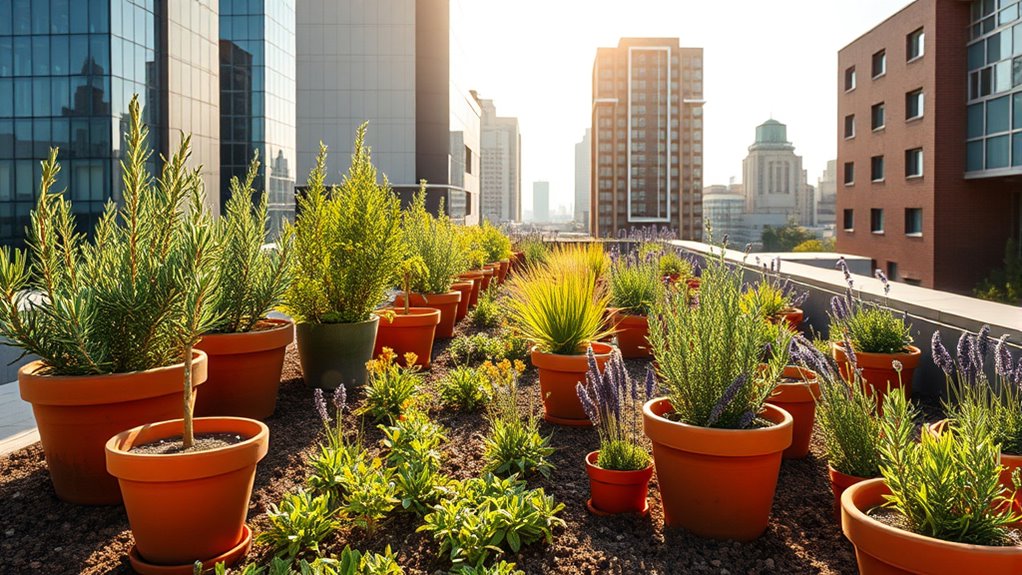
Optimizing sunlight and soil conditions in city environments requires strategic planning to make the most of limited space and urban challenges. To maximize light, consider these steps:
- Tree Placement: Position trees carefully to provide shade without blocking essential sunlight for your plants.
- Reflective Surfaces: Use mirrors or reflective materials to bounce sunlight into shaded areas and brighten dark spots.
- Shade Structures: Incorporate pergolas, umbrellas, or sails to create comfortable shaded zones while still allowing light to reach sun-loving plants.
- Understanding plant behavior and environmental interactions can help tailor your setup for optimal growth Relationships – Personality Test.
For soil, focus on:
- Ensuring good drainage with well-draining, drought-tolerant soils.
- Using organic fertilizers to boost soil health without overloading nutrients.
- Managing slopes through terracing and retaining walls to prevent erosion and improve root stability.
Water Conservation Strategies and Efficient Irrigation Methods

Water conservation is essential for maintaining a sustainable Mediterranean garden, especially in urban environments where water resources are limited. To do this, apply organic mulch to retain soil moisture, suppress weeds, and protect roots from temperature swings. Choose drought-tolerant native plants that need less water once established. Schedule deep, infrequent watering during cooler parts of the day to minimize evaporation. Collect rainwater through harvesting systems to reduce reliance on municipal supplies. Use drip irrigation or low-flow devices like soaker hoses to deliver water directly to plant roots, reducing waste. Incorporate moisture sensors and automated controllers to optimize watering. Additionally, enhance soil health with organic amendments to increase water retention and plant resilience. Healthy soil improves water absorption and retention, which further supports drought resistance in your garden. Incorporating smart watering technologies can further increase efficiency by adjusting watering schedules based on real-time weather data. These strategies help create an efficient, eco-friendly garden in urban settings.
Incorporating Natural Materials for a Mediterranean Aesthetic
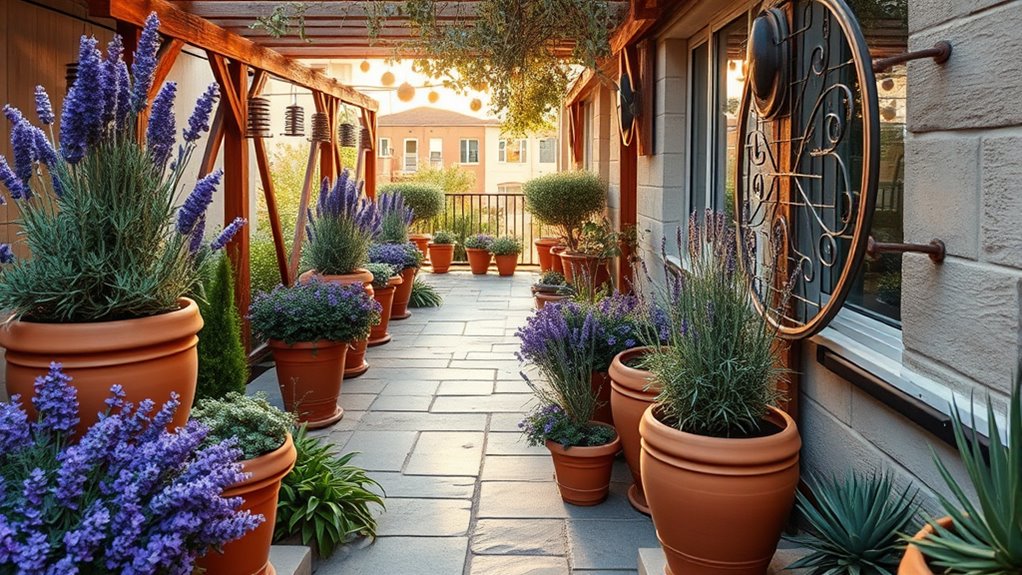
To achieve an authentic Mediterranean look, focus on choosing natural, locally sourced materials like limestone, terracotta, and gravel that reflect regional character. Using sustainable practices, such as repurposing old bricks or incorporating rammed earth, helps you create a durable, eco-friendly garden. By selecting materials that resonate with the landscape, you enhance both the beauty and sustainability of your outdoor space. Utilizing drought-resistant plants further contributes to a low-maintenance, water-efficient Mediterranean garden that thrives in hot, dry climates.
Choosing Authentic Materials
Choosing authentic materials is essential for capturing the true spirit of a Mediterranean garden. You want to select elements that reflect the warm, earthy tones and natural textures typical of the region. Here are three key options:
- Terracotta and Ceramic Containers – Oversized pots with drainage holes add rustic charm, while grouping smaller colorful pots brings vibrant touches. Make sure they’re frost-proof for colder climates.
- Natural Stone and Gravel – Use warm-toned stones for walls, terraces, and pathways to evoke Mediterranean warmth. Gravel or pebbles serve as drought-tolerant ground covers, reducing water needs.
- Decorative Tiles and Mosaics – Incorporate brightly colored, patterned glazed tiles for accents, and create mosaics from small stones or broken tiles to add traditional artistry and visual interest.
Stick to earthy hues and weathered finishes for an authentic look. Natural landscape elements are often integrated seamlessly into Mediterranean gardens to enhance their organic feel.
Sustainable Material Practices
Incorporating natural materials into your Mediterranean garden not only enhances its authentic charm but also promotes sustainability and durability. Use stone and terracotta, as they withstand outdoor conditions and age beautifully, developing appealing patinas. Locally sourced stone and wood cut down on transportation emissions and reduce environmental impact. Natural materials like gravel and wood chips improve soil health, support native plants, and encourage biodiversity. Wooden pergolas and trellises offer durable, eco-friendly shade solutions, supporting climbing plants like grape or bougainvillea. Water features built from natural stone blend seamlessly into the landscape, while rainwater harvesting and recycling boost sustainability. These materials naturally moderate temperature and humidity, create textured visual layers, and reinforce regional character—all while supporting ecological balance and long-term garden resilience. Soil erosion is a common issue in the region, making the use of natural materials even more vital for protecting and stabilizing garden landscapes. Incorporating native plants can further enhance the ecological harmony of your Mediterranean garden and improve its resilience to local climate conditions.
Designing for Climate Resilience and Low Maintenance
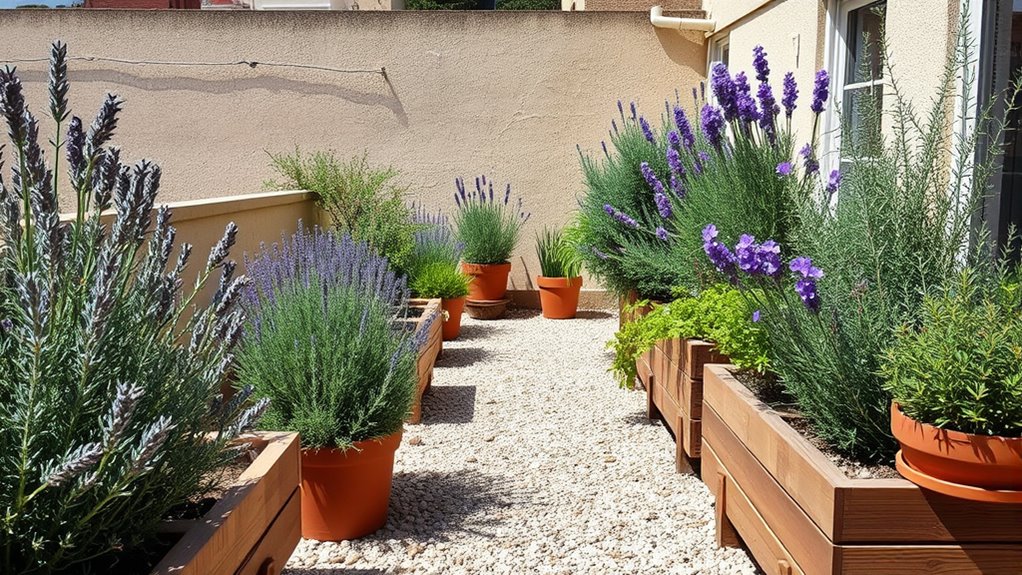
Designing for climate resilience and low maintenance in a Mediterranean garden involves selecting hardy, drought-tolerant plants that thrive with minimal intervention. Focus on native species like olives, citrus, figs, rosemary, thyme, and oregano, which tolerate hot, dry summers and mild winters. To boost resilience, incorporate plant diversity with fruit trees and shrubs that improve soil nutrients and ecosystem stability. Use plants with deep roots to access groundwater and reduce surface water dependence. The Mediterranean climate’s characteristic dry summers make drought-tolerant plants essential for sustainable gardening. You can further enhance resilience by: 1. Installing drip irrigation and rainwater harvesting to conserve water efficiently. 2. Applying mulch to retain soil moisture and regulate temperature. 3. Creating microclimates with shade structures and strategic placement to reduce heat and wind stress.
Enhancing Urban Gardens With Vertical and Container Planting
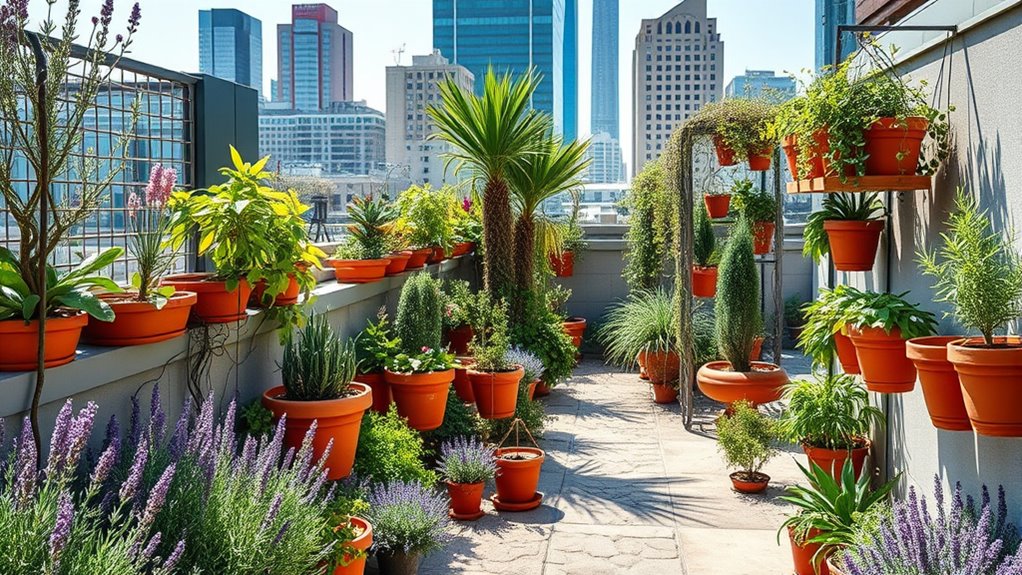
Maximizing vertical space transforms small urban gardens into highly productive and visually appealing areas. Vertical gardening allows you to grow up to ten times more crops per square foot than traditional planting, perfect for limited spaces like balconies and patios. Use walls, fences, or freestanding structures with techniques like trellising, terracing, and tumbling plants to optimize light and space. Select plants suited for vertical growth, such as herbs, trailing vines, and compact vegetables, considering sunlight, water, and climate. Install sturdy support systems like wall-mounted planters or hanging baskets, and incorporate drainage and automated watering for plant health. Position your vertical garden on south or west-facing walls for maximum sunlight. Incorporating dog-friendly plants can also make your urban garden more welcoming for pets. These gardens improve air quality, reduce urban heat, and add beauty and biodiversity to your city space.
Frequently Asked Questions
How Can I Create Privacy in a Small Mediterranean-Style Garden?
To create privacy in your small garden, start by using tall planters with trees like olive or Japanese maples to form natural screens. Add pergolas with climbing vines such as bougainvillea or wisteria for shaded, secluded spots. Incorporate hedges or trellises to block views while adding greenery. Arrange seating in cozy, tucked-away areas, and consider water features to mask noise, creating a peaceful, private oasis.
What Are the Best Native Plants for Urban Mediterranean Gardens?
Imagine your garden as a lively tapestry woven with native plants that thrive effortlessly. You’ll want drought-tolerant favorites like catmint and lavender, which burst with color and scent. Incorporate olive trees and rosemary for structure, and groundcovers like yarrow and red valerian to fill spaces. These plants support wildlife, resist drought, and give your urban oasis a vibrant, resilient charm that feels both wild and cultivated.
How Do I Prevent Pests Without Using Chemical Pesticides?
You can prevent pests naturally by encouraging beneficial predators like ladybugs and lacewings in your garden. Remove fallen fruits and weeds to eliminate breeding sites. Use physical barriers such as insect-proof netting and sticky traps to block pests. Apply organic solutions like neem oil or homemade botanical sprays to deter pests without chemicals. Pruning and proper watering improve plant health, making them less attractive to pests and reducing infestations effectively.
Can I Incorporate Edible Plants Into My Mediterranean Landscape?
Imagine your garden as a vibrant tapestry, where edible plants like figs, citrus, and tomatoes weave seamlessly with ornamental elements. You can incorporate these edibles by planting them in raised beds, containers, or along natural stone borders. Focus on full sun, well-draining soil, and smart water management. With thoughtful placement and careful planning, your landscape becomes a delicious, beautiful mosaic that reflects your Mediterranean spirit.
What Maintenance Practices Are Essential for Long-Term Garden Health?
You need to prioritize regular maintenance practices to guarantee your garden stays healthy long-term. Water deeply but infrequently, especially during dry months, and prune plants to encourage growth. Keep soil fertile with compost and organic fertilizers, and mulch to conserve moisture. Remove weeds regularly and protect delicate plants in winter. Raking pathways and cleaning water features also help maintain a vibrant, thriving garden that withstands seasonal changes.
Conclusion
By adopting these Mediterranean gardening techniques, your urban space transforms into a lush oasis amid concrete jungles. Think of your garden as a living mosaic, where drought-resistant plants and smart design weave together resilience and beauty. With careful planning and sustainable practices, you’ll create a vibrant retreat that thrives with minimal effort. Your small space becomes a Mediterranean paradise—a gust of fresh inspiration in the heart of the city, blossoming against all odds.


